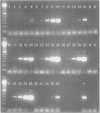Abstract
Mycobacterium paratuberculosis is a recognized chronic enteric pathogen that can affect many different species of animals, including primates. It has been suggested that this organism is associated with Crohn's disease in humans, and that milk is a potential source of human exposure to this organism. The limit of the detection of M. paratuberculosis in milk samples by direct PCR was 10(5) cfu/mL if the traditional boiling method was used for template DNA preparation. In this study, an improved method for template DNA preparation was examined. The method involves the use of a bead beater, which breaks up bacterial cell wall mechanically by vibrating bacteria with microbeads at high speed. The effectiveness of this method for lysing M. paratuberculosis cells was compared to that of the freeze-thaw method, and use of commercial kits such as the InstaGene Matrix and the QIAamp Tissue Kit. The bead beater procedure was tested in combination with various cell lysis and template DNA preparation procedures to determine which of these steps improved the limit of detection of PCR assay that amplifies a 413 bp fragment of the IS900 gene. Results showed that the use of the bead beater, in combination with the use of lysis buffer, boiling, and isopropanol precipitation, decreased the limit of detection of M. paratuberculosis in milk by the PCR to 10(2) cfu/mL. The limit of detection was further decreased to 10 cfu/mL when 0.0037% bovine serum albumin was included in the PCR reaction mixtures. The improved assay was 10- to 10(4)-fold more sensitive than the PCR assays using template DNA prepared by other lysis procedures including boiling alone, freeze-thaw plus boiling, or use of commercial kits for lysis.
Full text
PDF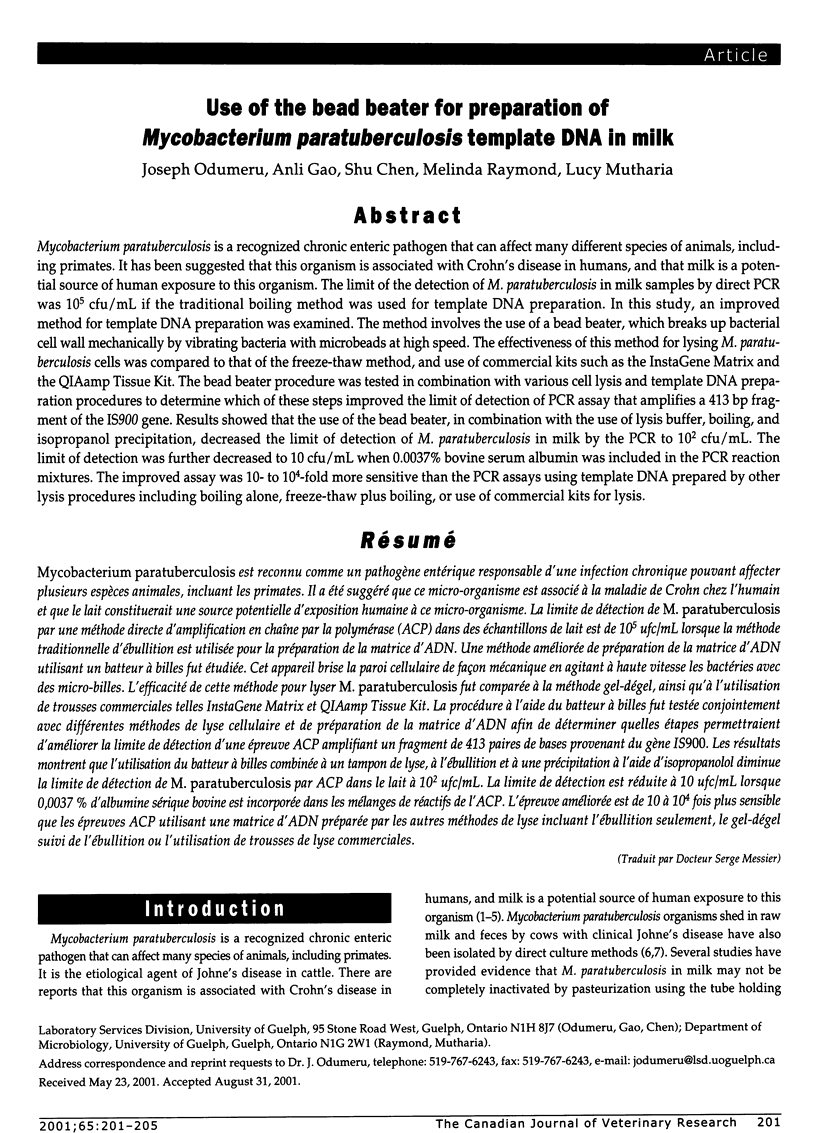
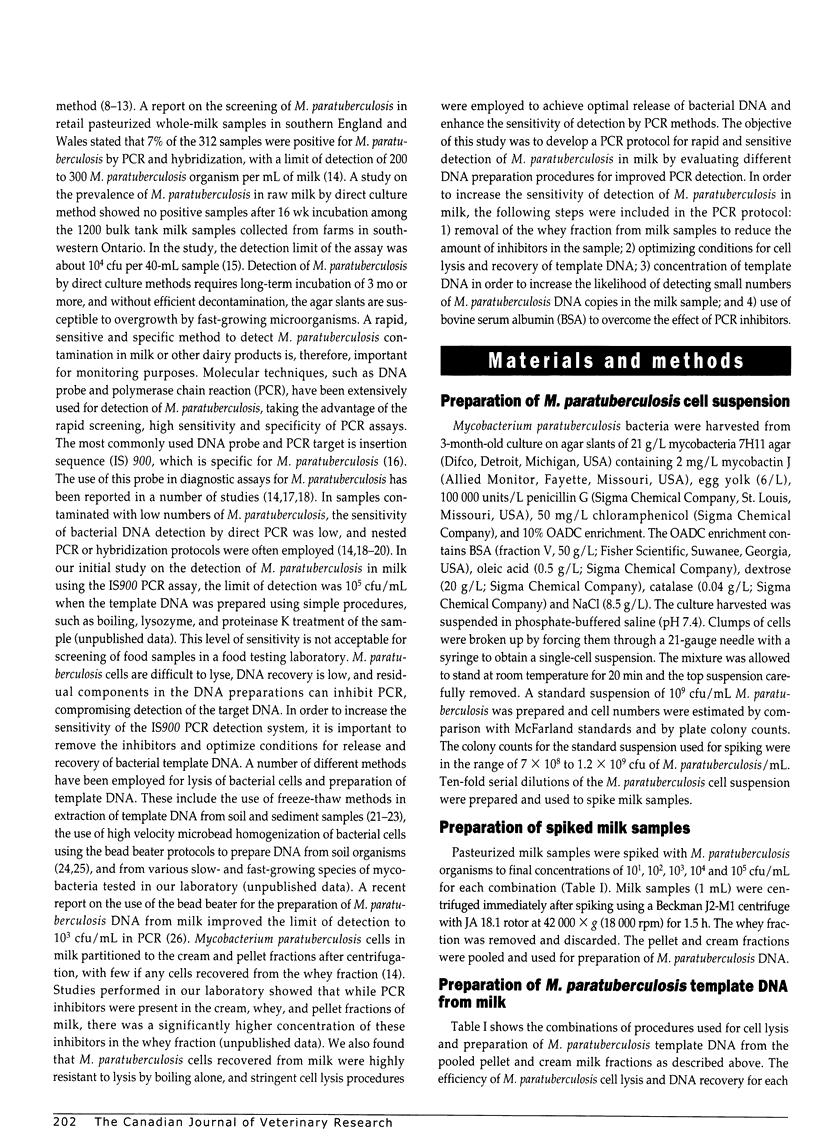
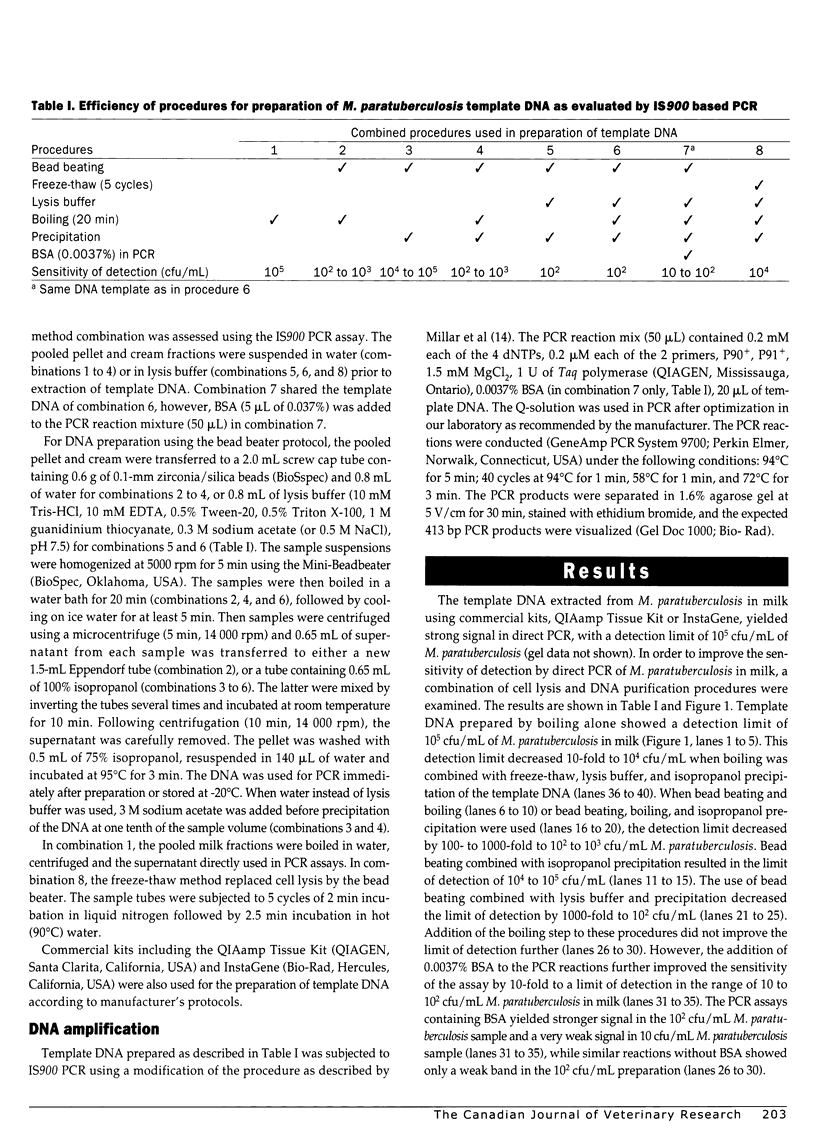
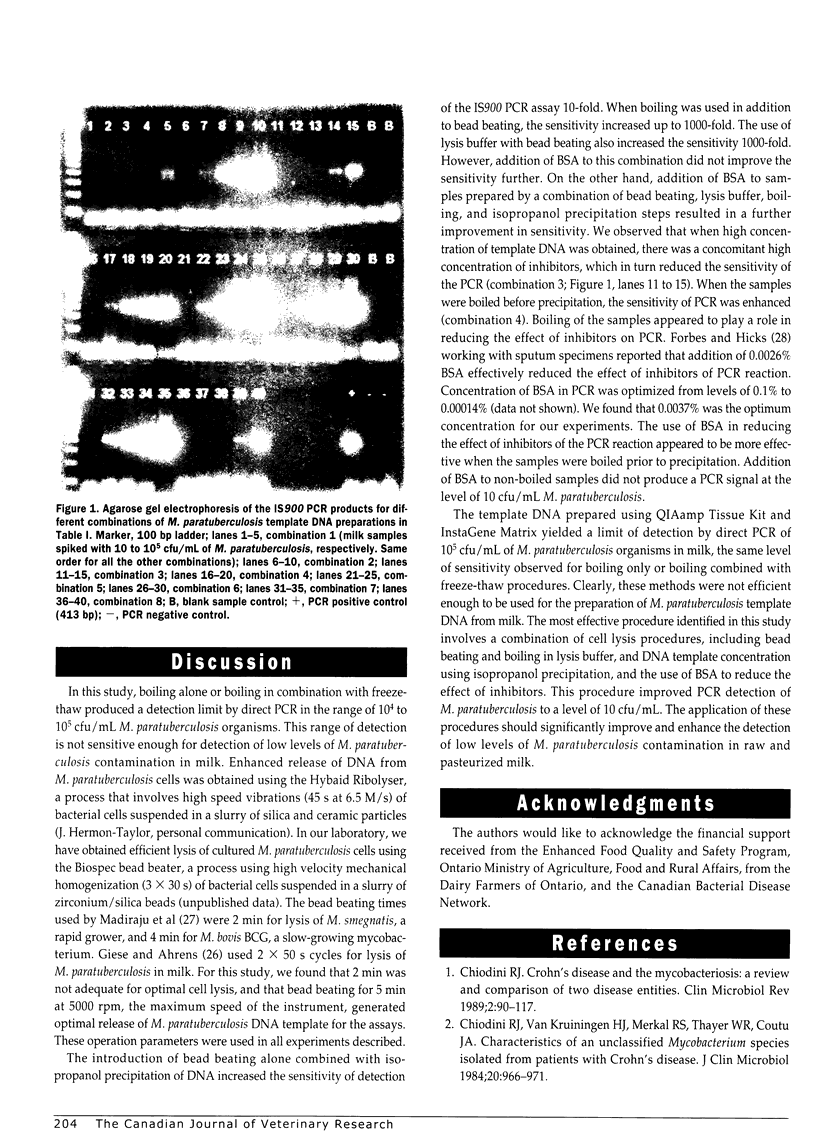
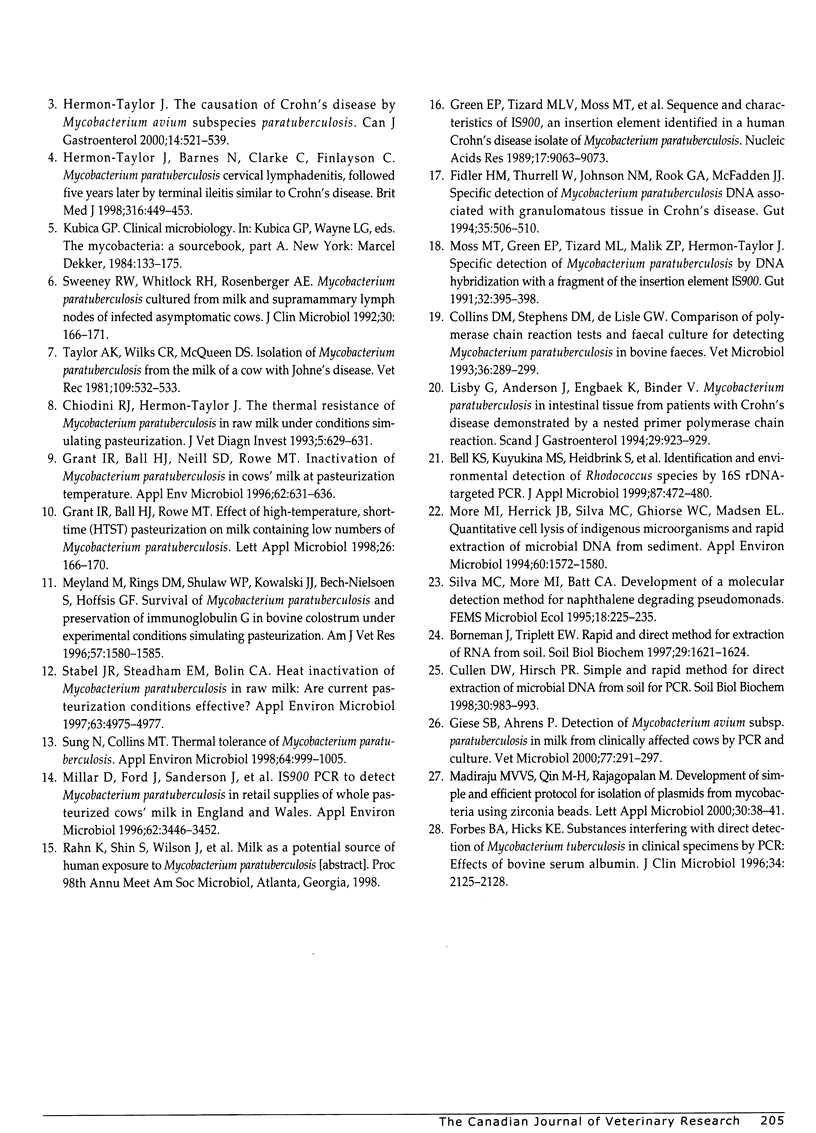
Images in this article
Selected References
These references are in PubMed. This may not be the complete list of references from this article.
- Bell K. S., Kuyukina M. S., Heidbrink S., Philp J. C., Aw D. W., Ivshina I. B., Christofi N. Identification and environmental detection of Rhodococcus species by 16S rDNA-targeted PCR. J Appl Microbiol. 1999 Oct;87(4):472–480. doi: 10.1046/j.1365-2672.1999.00824.x. [DOI] [PubMed] [Google Scholar]
- Chiodini R. J., Hermon-Taylor J. The thermal resistance of Mycobacterium paratuberculosis in raw milk under conditions simulating pasteurization. J Vet Diagn Invest. 1993 Oct;5(4):629–631. doi: 10.1177/104063879300500424. [DOI] [PubMed] [Google Scholar]
- Chiodini R. J., Van Kruiningen H. J., Merkal R. S., Thayer W. R., Jr, Coutu J. A. Characteristics of an unclassified Mycobacterium species isolated from patients with Crohn's disease. J Clin Microbiol. 1984 Nov;20(5):966–971. doi: 10.1128/jcm.20.5.966-971.1984. [DOI] [PMC free article] [PubMed] [Google Scholar]
- Collins D. M., Stephens D. M., de Lisle G. W. Comparison of polymerase chain reaction tests and faecal culture for detecting Mycobacterium paratuberculosis in bovine faeces. Vet Microbiol. 1993 Sep;36(3-4):289–299. doi: 10.1016/0378-1135(93)90095-o. [DOI] [PubMed] [Google Scholar]
- Fidler H. M., Thurrell W., Johnson N. M., Rook G. A., McFadden J. J. Specific detection of Mycobacterium paratuberculosis DNA associated with granulomatous tissue in Crohn's disease. Gut. 1994 Apr;35(4):506–510. doi: 10.1136/gut.35.4.506. [DOI] [PMC free article] [PubMed] [Google Scholar]
- Forbes B. A., Hicks K. E. Substances interfering with direct detection of Mycobacterium tuberculosis in clinical specimens by PCR: effects of bovine serum albumin. J Clin Microbiol. 1996 Sep;34(9):2125–2128. doi: 10.1128/jcm.34.9.2125-2128.1996. [DOI] [PMC free article] [PubMed] [Google Scholar]
- Giese S. B., Ahrens P. Detection of Mycobacterium avium subsp. paratuberculosis in milk from clinically affected cows by PCR and culture. Vet Microbiol. 2000 Dec 20;77(3-4):291–297. doi: 10.1016/s0378-1135(00)00314-x. [DOI] [PubMed] [Google Scholar]
- Grant I. R., Ball H. J., Neill S. D., Rowe M. T. Inactivation of Mycobacterium paratuberculosis in cows' milk at pasteurization temperatures. Appl Environ Microbiol. 1996 Feb;62(2):631–636. doi: 10.1128/aem.62.2.631-636.1996. [DOI] [PMC free article] [PubMed] [Google Scholar]
- Grant I. R., Ball H. J., Rowe M. T. Effect of high-temperature, short-time (HTST) pasteurization on milk containing low numbers of Mycobacterium paratuberculosis. Lett Appl Microbiol. 1998 Feb;26(2):166–170. doi: 10.1046/j.1472-765x.1998.00309.x. [DOI] [PubMed] [Google Scholar]
- Green E. P., Tizard M. L., Moss M. T., Thompson J., Winterbourne D. J., McFadden J. J., Hermon-Taylor J. Sequence and characteristics of IS900, an insertion element identified in a human Crohn's disease isolate of Mycobacterium paratuberculosis. Nucleic Acids Res. 1989 Nov 25;17(22):9063–9073. doi: 10.1093/nar/17.22.9063. [DOI] [PMC free article] [PubMed] [Google Scholar]
- Hermon-Taylor J., Barnes N., Clarke C., Finlayson C. Mycobacterium paratuberculosis cervical lymphadenitis, followed five years later by terminal ileitis similar to Crohn's disease. BMJ. 1998 Feb 7;316(7129):449–453. doi: 10.1136/bmj.316.7129.449. [DOI] [PMC free article] [PubMed] [Google Scholar]
- Hermon-Taylor J., Bull T. J., Sheridan J. M., Cheng J., Stellakis M. L., Sumar N. Causation of Crohn's disease by Mycobacterium avium subspecies paratuberculosis. Can J Gastroenterol. 2000 Jun;14(6):521–539. doi: 10.1155/2000/798305. [DOI] [PubMed] [Google Scholar]
- Lisby G., Andersen J., Engbaek K., Binder V. Mycobacterium paratuberculosis in intestinal tissue from patients with Crohn's disease demonstrated by a nested primer polymerase chain reaction. Scand J Gastroenterol. 1994 Oct;29(10):923–929. doi: 10.3109/00365529409094864. [DOI] [PubMed] [Google Scholar]
- Madiraju M. V., Qin M. H., Rajagopalan M. Development of simple and efficient protocol for isolation of plasmids from mycobacteria using zirconia beads. Lett Appl Microbiol. 2000 Jan;30(1):38–41. doi: 10.1046/j.1472-765x.2000.00619.x. [DOI] [PubMed] [Google Scholar]
- Meylan M., Rings D. M., Shulaw W. P., Kowalski J. J., Bech-Nielsen S., Hoffsis G. F. Survival of Mycobacterium paratuberculosis and preservation of immunoglobulin G in bovine colostrum under experimental conditions simulating pasteurization. Am J Vet Res. 1996 Nov;57(11):1580–1585. [PubMed] [Google Scholar]
- Millar D., Ford J., Sanderson J., Withey S., Tizard M., Doran T., Hermon-Taylor J. IS900 PCR to detect Mycobacterium paratuberculosis in retail supplies of whole pasteurized cows' milk in England and Wales. Appl Environ Microbiol. 1996 Sep;62(9):3446–3452. doi: 10.1128/aem.62.9.3446-3452.1996. [DOI] [PMC free article] [PubMed] [Google Scholar]
- Moré M. I., Herrick J. B., Silva M. C., Ghiorse W. C., Madsen E. L. Quantitative cell lysis of indigenous microorganisms and rapid extraction of microbial DNA from sediment. Appl Environ Microbiol. 1994 May;60(5):1572–1580. doi: 10.1128/aem.60.5.1572-1580.1994. [DOI] [PMC free article] [PubMed] [Google Scholar]
- Moss M. T., Green E. P., Tizard M. L., Malik Z. P., Hermon-Taylor J. Specific detection of Mycobacterium paratuberculosis by DNA hybridisation with a fragment of the insertion element IS900. Gut. 1991 Apr;32(4):395–398. doi: 10.1136/gut.32.4.395. [DOI] [PMC free article] [PubMed] [Google Scholar]
- Stabel J. R., Steadham E. M., Bolin C. A. Heat inactivation of Mycobacterium paratuberculosis in raw milk: are current pasteurization conditions effective? Appl Environ Microbiol. 1997 Dec;63(12):4975–4977. doi: 10.1128/aem.63.12.4975-4977.1997. [DOI] [PMC free article] [PubMed] [Google Scholar]
- Sung N., Collins M. T. Thermal tolerance of Mycobacterium paratuberculosis. Appl Environ Microbiol. 1998 Mar;64(3):999–1005. doi: 10.1128/aem.64.3.999-1005.1998. [DOI] [PMC free article] [PubMed] [Google Scholar]
- Sweeney R. W., Whitlock R. H., Rosenberger A. E. Mycobacterium paratuberculosis cultured from milk and supramammary lymph nodes of infected asymptomatic cows. J Clin Microbiol. 1992 Jan;30(1):166–171. doi: 10.1128/jcm.30.1.166-171.1992. [DOI] [PMC free article] [PubMed] [Google Scholar]
- Taylor T. K., Wilks C. R., McQueen D. S. Isolation of Mycobacterium paratuberculosis from the milk of a cow with Johne's disease. Vet Rec. 1981 Dec 12;109(24):532–533. [PubMed] [Google Scholar]



